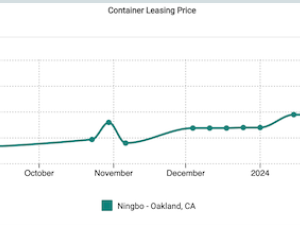At the center of the TSA recommendation for upcoming contracts ' most taking effect on May 1, 2011 ' are suggested rate increases of US$400 per 40-foot container (FEU) for cargo moving to U.S. West Coast ports and $600 per FEU for all other cargo. TSA lines have further recommended full recovery of costs for other equipment sizes, and improved collection of floating bunker and inland fuel charges as well as Panama Canal, Alameda Corridor and other fixed accessorial charges.
Carriers called for adjustments to store-door delivery rates as warranted, to levels that adequately compensate carriers for rising costs in providing those services. Finally, TSA is recommending a peak season surcharge of $400 per FEU, effective from June 15, 2011 through November 30, 2011, with those dates subject to adjustment based on changing market conditions.
TSA carriers noted a dramatic tradewide improvement in the supply-demand situation for freight shippers during 2010. Asia-US cargo growth for the year has been surprisingly strong, and is forecast to settle near 12% by yearend. According to industry analysts AXS.
Alphaliner, transpacific capacity grew by 18.6% in the year since November 2009. The first three quarters of 2010 saw 15 new and restored services enter the trade to meet demand, in part the result of improved rate levels. These included three new operators.
Looking ahead, TSA lines forecast high single-digit cargo growth from Asia to the U.S. in 2011, in the 6-9% range. Meeting that demand and covering contingencies for a possible stronger recovery will require sustained revenue improvement.
'The transpacific market is clearly returning to some kind of 'normality', with the U.S. and Asian economies still closely linked and imports from Asia still vital to U.S. consumers and businesses,' TSA chairman and Hanjin Shipping Co. Ltd. CEO Y.M. Kim said. But he cautioned that added revenue is also necessary to support the service levels customers have come to expect in this trade. 'Maintaining a stable infrastructure for the movement of goods is no less important today than in past years, and that will take sustained levels of carrier investment over time.'
Carriers acknowledged that the financial picture has improved significantly this year, as the world economy has started to recover from the financial crisis of 2008-9. However, further revenue recovery is needed to restore financial stability. 'Carriers have experienced solid revenue growth across their entire networks in 2010, but two strong quarters in the transpacific ' a highly competitive freight market with very thin margins ' still do not fully offset two years of heavy losses,' Kim explained. 'We said last year that we would not seek to recover all our losses in one year.'
Agreement executive administrator Brian M. Conrad pointed out that a number of operating costs have continued to rise steadily, including labor, container handling, inland transport, and both purchase and leasing of container equipment during the persistent global shortage. Appreciation of some Asian currencies has effectively increased local currency costs relative to U.S. dollar-denominated freight rates. Conrad said individual lines would be discussing with customers in greater detail the background to their revenue and cost recovery objectives as contract negotiations move forward.
TSA is a research and discussion forum of major container shipping lines serving the trade from Asia to ports and inland points in the U.S. More information on TSA can be found at www.ts





